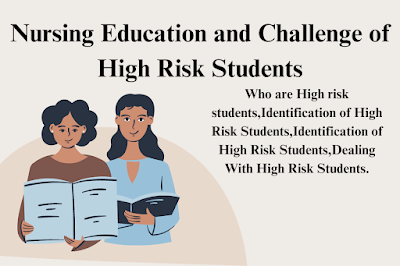Nursing Education and Challenge of High Risk Students Introduction
High-risk students in nursing education represent a critical concern for educators and institutions. These students, often characterized by various socio-economic, academic, and personal challenges, require targeted support to succeed in their nursing programs. Given the projected shortage of registered nurses and the increasing proportion of high-risk students, addressing their needs is essential for both educational success and meeting public health demands. This article explores who high-risk students are, methods for identifying them, and effective strategies for supporting their academic success.
Who Are High-Risk Students?
High-risk students are individuals who face increased likelihood of academic difficulties due to a range of factors that may impact their performance and retention in nursing education programs. These factors can include limited social support, inadequate resources, cognitive challenges, or personal circumstances that predispose them to poor academic outcomes.
Characteristics of High-Risk Students
- Socioeconomic Status: Students from economically disadvantaged backgrounds often encounter barriers such as limited access to educational resources, financial instability, and external pressures that can adversely affect their academic performance.
- Ethnic and Minority Status: Ethnic minority students may face additional challenges such as cultural disconnection, discrimination, and lower access to educational support systems, which can impact their academic success.
- Gender: Gender-related issues, including stereotypes and biases, can influence the academic experiences and performance of students, particularly in fields traditionally dominated by one gender.
- Disability Status: Students with disabilities may require special accommodations and support to navigate the demands of nursing education. Without adequate support, they may struggle to meet academic and clinical requirements.
- Behavioral and Emotional Challenges: Students exhibiting behavioral dysfunction or emotional difficulties may find it challenging to maintain focus, motivation, and academic performance.
- Prior Academic Performance: Historical academic struggles, such as low GPA or standardized test scores, can be indicators of potential difficulties in nursing education.
Identification of High-Risk Students
Identifying high-risk students early is crucial for implementing supportive interventions and improving retention rates. This process involves evaluating both academic and non-academic factors to assess the likelihood of success in nursing programs.
Methods for Identification
- Pre-Admission Evaluation: Analyzing pre-admission characteristics can provide insight into a student’s potential risk. Factors such as high school GPA, standardized test scores, and previous academic performance are critical indicators.
- Academic Variables: Monitoring academic performance through standardized tests, course grades, and cumulative GPA helps identify students who may be struggling. These metrics can serve as early warning signs of potential issues.
- Non-Academic Variables: Assessing non-academic factors, such as the quality of prior education, self-efficacy, anxiety levels, and stress, provides a more comprehensive view of the student’s overall readiness for nursing education.
- Social and Emotional Factors: Evaluating aspects such as social support networks, emotional resilience, and coping mechanisms can highlight students who may need additional support.
- Institutional Data: Analyzing data on student demographics, retention rates, and performance trends can help identify patterns and high-risk groups within the nursing program.
Dealing with High-Risk Students
Effectively supporting high-risk students requires a multifaceted approach that addresses their unique needs and challenges. Implementing evidence-based strategies and creating a supportive educational environment are essential for fostering academic success.
Strategies for Supporting High-Risk Students
- Personalized Support: Tailoring support to the individual needs of high-risk students is crucial. This may include academic advising, mentoring, and individualized learning plans that address specific challenges.
- Holistic Support Systems: Providing comprehensive support that encompasses educational, social, financial, emotional, and cultural aspects can help students overcome barriers to success. This approach might involve connecting students with counseling services, tutoring, financial aid, and peer support groups.
- Academic Interventions: Implementing targeted academic interventions such as remedial courses, study groups, and skills workshops can help students build the necessary competencies for success in nursing education.
- Instructional Strategies: Adapting instructional methods to align with students’ learning styles and needs can enhance their engagement and understanding. Utilizing formative feedback, interactive technologies, and varied teaching approaches can cater to diverse learning preferences.
- Fostering Resilience: Encouraging self-efficacy and resilience through skill-building activities and stress management programs can help students navigate challenges and maintain motivation.
- Creating an Inclusive Environment: Promoting an inclusive and supportive educational environment helps high-risk students feel valued and engaged. This involves addressing potential biases, fostering a sense of belonging, and providing culturally sensitive support.
Conclusion
High-risk students in nursing education face a range of challenges that can impact their academic success and future career prospects. Identifying these students early and implementing effective support strategies are essential for improving their chances of success and addressing the broader nursing workforce shortage.
The identification of high-risk students involves evaluating a combination of academic and non-academic factors, including socioeconomic background, prior academic performance, and personal circumstances. By addressing these factors through personalized support, holistic interventions, and inclusive practices, nursing educators can help mitigate the risks faced by these students and enhance their educational outcomes.
Future research should focus on developing and testing strategies for early identification and support, considering social determinants, cognitive processing, and interactive educational technologies. As nursing education continues to evolve, understanding and addressing the needs of high-risk students will be vital for building a diverse, competent, and resilient nursing workforce.
